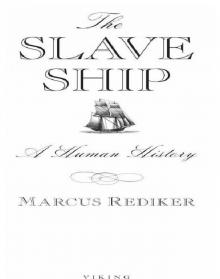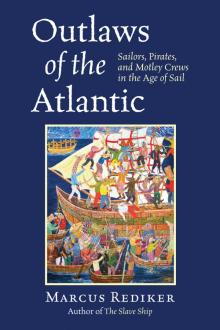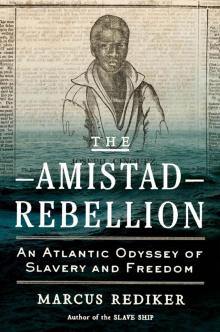- Home
- Marcus Rediker
Villains of All Nations Page 12
Villains of All Nations Read online
Page 12
Of the existence of two women pirates by the names of Anne Bonny and Mary Read there can be no doubt, for they were mentioned in a variety of historical sources, all independent of A General History of the Pyrates. The names first appeared in a proclamation by Woodes Rogers, governor of the Bahama Islands, who on September 5, 1720, declared Jack Rackam and his crew to be pirates and warned all authorities to treat them as “Enemies to the Crown of Great Britain.” He named the pirates involved and noted “Two women, by name, Ann Fulford alias Bonny, & Mary Read.” The second mention came in a pamphlet, The Tryals of Captain John Rackam and Other Pirates, published in Jamaica in 1721. At about the same time Governor Nicholas Lawes wrote from Jamaica to the Council of Trade and Plantations that “the women, spinsters of Providence Island, were proved to have taken an active part in piracies, wearing men’s clothes and armed etc.” Finally, newspaper reports in the American Weekly Mercury, the Boston Gazette, and the Boston News-Letter mentioned but did not name the two women pirates who were members of Rackam’s crew.5
The Tryals of Captain John Rackam and Other Pirates presents testimony from the trial and verifies crucial parts of Johnson’s General History, independently establishing Bonny and Read as fierce, swashbuckling women, genuine pirates in every sense.6 One of the witnesses against Bonny and Read was Dorothy Thomas, who had been captured and made prisoner by Rackam’s crew. She claimed that the women “wore Mens Jackets, and long Trouzers, and Handkerchiefs tied about their Heads, and that each of them had a Machet[e] and Pistol in their Hands.” Moreover, at one point they “cursed and swore at the Men,” their fellow pirates, “to murther the Deponent.” “[T]hey should kill her,” they growled, “to prevent her coming against them” in court, as was indeed happening before their very eyes. At the time, Bonny and Read were dressed as men, but they did not fool Thomas: “the Reason of her knowing and believing them to be Women was, by the largeness of their Breasts.”7
John Besnick and Peter Cornelius, likewise captives of Rackam and his crew, testified that Bonny and Read “were very active on Board, and willing to do any Thing.” Bonny apparently worked as a powder monkey in times of engagement: she “handed gun-powder to the Men.”8 When Rackam and his crew “saw any vessel, gave Chase or Attack’d,” Bonny and Read wore men’s clothes, but at other times, free of military confrontation, they wore women’s clothes. According to these witnesses, the women “did not seem to be kept, or detain’d by Force,” but rather took part in piracy “of their own Free-Will and Consent.” Thomas Dillon, a captured master of a merchant vessel, added that they “were both very profligate, cursing, and swearing much, and very ready and willing to do any Thing on board.”9
Despite the general authenticity of the tales,10 many modern readers must surely have doubted them, thinking them descriptions of the impossible. After all, women never went to sea; seafaring was a man’s world and a man’s world only. But recent research throws doubt on such assumptions. Linda Grant Depauw has shown that women went to sea in many capacities: as passengers, servants, wives, prostitutes, laundresses, cooks, and occasionally—though certainly much less often—even as sailors, serving aboard naval, merchant, whaling, privateering, and pirate vessels.11 Dianne Dugaw has written: “Perhaps the most surprising fact about eighteenth-century female soldiers and sailors is their frequency, not only in fiction but in history as well.”12 An anonymous British writer, possibly the dramatist and poet Oliver Goldsmith, wrote in 1762 that there were so many women in the British army that they deserved their own separate battalion, perhaps not unlike the contemporaneous women warriors who fought for the African kingdom of Dahomey.13
So Bonny and Read rigged themselves out in men’s clothes and carried their bold imposture into the always rough, sometimes brutal world of maritime labor. Their cross-dressing adventures were not as unusual among early modern women as previously believed, but they were nonetheless direct challenges to customary maritime practice, which forbade women to work as seamen aboard deep-sea vessels of any kind. The reasons for the exclusion are not yet clear, but the evidence of it is incontrovertible: the ship was a sharply gendered workplace, reserved almost exclusively for male labor. Seafaring was a line of work long thought to “make a man” of anyone who entered.14
One reason women found no berth may have been the sheer physical strength and stamina required for early modern maritime labor. Employing at this time a low level of machine power, the ship depended on brute strength for many of its crucial operations—assisting in the loading and unloading of cargo (using pulleys and tackle), setting heavy canvas sails, and operating the ship’s pump to eliminate the water that oozed through the seams of always-leaky vessels. A few women, obviously, did the work and did it well, earning the abiding respect of their fellow workers. But not everyone—certainly not all men—was equal to its demands. It was simply too strenuous, too hard on the body, leaving in its wake lameness, hernias, a grotesque array of mutilations, and often premature death.15
A second and perhaps more important reason for the segregation of the sexes was the apparently widespread belief that women and sexuality more generally were inimical to work and social order aboard the ship. Arthur N. Gilbert has convincingly shown that homosexual practice in the eighteenth-century British Royal Navy was punished ruthlessly because it was considered subversive of discipline and good order.16 Minister John Flavel made the same point when he wrote that the death of the “lusts” of seamen was a means of giving “life” to the merchant’s trade, which made the saving of souls and the accumulation of capital complementary parts of a single disciplinary process.17 But some version of his view apparently commanded acceptance at all levels of the ship’s hierarchy. Many sailors saw women as objects of fantasy and adoration but also as sources of bad luck or, worse, dangerous sources of conflict, potential breaches in the male order of seagoing solidarity. Early modern seafarers seem to have agreed among themselves that some kind of sexual repression was necessary to do the work of the ship.18
The assumption was strong enough to command at least some assent from pirates, who, as we have seen, organized their ships in otherwise novel and egalitarian ways. The freebooters who sailed the Mediterranean in the early seventeenth century refused to allow women aboard the ships because their presence was “too distracting.”19 The refusal was continued into the eighteenth century. The articles drawn up by Bartholomew Roberts and his crew specified that no boy or woman was to be allowed on board. Moreover, should a woman passenger be taken as a captive, “they put a Centinel immediately over her to prevent ill Consequences from so dangerous an Instrument of Division and Quarrel.” The crew of John Phillips reasoned likewise: “If at any Time we meet with a prudent Woman, that Man that offers to meddle with her, without her Consent, shall suffer present Death.” Captain William Snelgrave added, “It is a rule amongst the Pirates, not to allow Women to be on board their Ships, when in the Harbour. And if they should Take a Prize at Sea, that has any Women on board, no one dares, on pain of death, to force them against their Inclinations. This being a good political Rule to prevent disturbances amongst them, it is strictly observed.”20
Black Bart Roberts was straighter laced than most pirate captains (he banned gambling among his crew to reduce conflict), so it may be unwise to hold up his example as typical.21 Another, perhaps more important doubt arises from evidence that Bonny and Read did not cross-dress all of the time aboard the pirate ship. As John Besnick and Peter Cornelius testified in court, they wore male attire during a chase or engagement, when a show of “manpower” might help to intimidate their prey and force a quick surrender. At other times, presumably during the daily running of the ship, they dressed as women.22
The strongest test of the attitudes of male pirates toward females is the actual number of women who appeared on the sea rovers’ ships in the early eighteenth century; the surviving evidence suggests that few of them did. Two other women faced charges for piracy in this era, both in Virginia, where authorities tried
Mary Harley (or Harvey) and three men for piracy in 1726, sentenced the three men to hang, but released the woman.23 Three years later they tried a gang of six pirates, including Mary Crickett (or Crichett), all of whom were ordered to the gallows. Crickett and Edmund Williams, the leader of the pirates, had been transported as felons to Virginia aboard the same ship in late 1728.24 It is not known whether Harley and Crickett cross-dressed to become pirates, nor if they were moved to do so by tales of Anne Bonny and Mary Read. The very presence of all four women among the pirates came to light only because their vessels were captured. Thus the pirate ship may have offered more room to women than either the merchant or the naval vessels of the day, but still it was little enough. And in any case, it existed only because radical female action created it in the first place.25
Bonny and Read were able to undertake such action in part because class experiences and personal characteristics enabled them to draw on and perpetuate a deeply rooted underground tradition of female cross-dressing, pan-European in its dimensions but especially strong in early modern England, the Netherlands, and Germany. Such disguise was usually, though not exclusively, undertaken by proletarian women.26 Like other female cross-dressers, Bonny and Read were young, single, and humble of origin; their illegitimate births were not uncommon. Moreover, Bonny and Read perfectly illustrated what historians Rudolf M. Dekker and Lotte C. van de Pol have identified as the two main reasons women cross-dressed in the early modern era; Read did it largely out of economic necessity, and Bonny, turning her back on her father’s fortune, followed her instincts for love and adventure.27
Bonny may have been drawn to the sea and to piracy in particular by popular lore in her native Ireland about Grace O’Malley, a pirate queen who in the late sixteenth century marauded up and down the Emerald Isle’s western coast. O’Malley was fierce of action and of visage; the face of this commanding figure had been badly scarred in her youth by the talons of an eagle. In 1577 Sir Henry Sydney wrote that O’Malley “was a notorious woman in all the coasts of Ireland.” Such coasts would have included the port of Cork, where O’Malley had often attacked the merchant ships that sailed to the Iberian Peninsula and where Bonny was born to a family of seafaring experience.28
In any event, Bonny and Read became part of a larger tradition that included such famous women as Christian Davies, who, dressed as a man, chased her dragooned husband from Dublin to the European continent, survived numerous battles, wounds, and capture by the French, and returned to England and to military honors bestowed by Queen Anne.29 Ann Mills went to sea “about the year 1740,” serving as “a common sailor on board the Maidstone frigate” during the War of Austrian Succession. She distinguished herself in hand-to-hand combat against “a French enemy” and “cut off the head of her opponent, as a trophy of victory.”30 Perhaps the best-known cross-dressing sailor of the eighteenth century was Hannah Snell, who ran away to sea in 1745 in search of a seafaring husband who had abandoned her during pregnancy. Accounts of her life appeared in Gentlemen’s Magazine, Scots Magazine, and in books long and short, in English and in Dutch.31
Figure 8. Ann Mills; James Caulfield, Portraits, Memoirs, and Characters of Remarkable Persons from the Revolution of 1688 to the End of the Reign of King George II (London, 1820).
Women such as Christian Davies, Ann Mills, and Hannah Snell were also celebrated in popular ballads around the Atlantic. A “semi-literate lower class” of “apprentices, servants, charwomen, farmworkers, laborers, soldiers, and sailors” sang the glories of “warrior women” at the fairs, on the wharves, around the street corners, and amid the mass gatherings at hangings.32 Bonny and Read came of age in an era when female warrior ballads soared to the peak of their popularity.33
Dianne Dugaw has pointed out that ballads about warrior women gave “a surprisingly accurate, if conventionalized, reading of lower-class [female] experience,” which as a matter of course bred physical strength, toughness, independence, fearlessness, and a capability of surviving by one’s wits. The prevailing material reality of working women’s lives made it possible for some women to disguise themselves and enter worlds dominated by men; the same reality then ensured that such women would be familiar enough within early working-class culture to be celebrated. Bonny and Read represented not the typical but the strongest side of popular womanhood.34
Their strength was a matter of body and mind, for the two women were well suited for maritime labor and piracy in ways both physical and temperamental. By the time she was a teenager, Read was already “growing bold and strong.” Bonny was described as “robust” and of “fierce and couragious temper.” In “times of Action, no Person amongst [the pirates] was more resolute, or ready to board or undertake any Thing that was hazardous” than Bonny and Read, not least because they had, by the time they sailed beneath the Jolly Roger, already endured all manner of hazards. Read’s mother had been married to “a Man who used the Sea” but in the end was himself apparently used up by it; Anne Bonny’s mother was a “Maid-Servant.” As illegitimate children, both faced shifting, precarious circumstances early in life. The art of survival in a rough proletarian world included a capacity for self-defense, which both Bonny and Read had mastered.35 Read’s experience in the British infantry and cavalry helped make her a fearsome duelist among the pirates. Bonny’s training was less formal but no less effective, as her would-be rapist would discover suddenly and painfully.36
Bonny and Read were thus well prepared to adopt the sailor’s and even the pirate’s cultural style, which they did with enthusiasm. They cursed and swore like any good sailor. They were, moreover, armed to the teeth, carrying their pistols and machetes like those well trained in the ways of war. They also affirmed one of the principal values and standards of conduct among both seamen and pirates, that is, an unwritten code of courage. Calico Jack Rackam got his big boost in the pirate world when his captain, Charles Vane, refused to engage a French man-of-war, which led immediately to charges of cowardice, a democratic vote of no confidence, and Rackam’s promotion from quartermaster to captain. Among sailors and especially pirates, courage was a principal means of survival, and cowardice was an invitation to disaster and ultimately death.37
Courage was traditionally seen as a masculine virtue, but Read and Bonny proved that women might possess it in abundance. They demonstrated it in the mutinies that launched each of them into piracy and again in the skirmish after which they were captured, when they fired a pistol into the hold, aiming at their quivering comrades. Read dreaded to hear her lover called a coward; Bonny called her own lover as much while the noose tightened around his neck in Port Royal. The strongest evidence of the importance of courage came in Read’s class-conscious answer to the question of a captive about her prospect of an “ignominious Death” on the gallows, when she gamely insisted “Men of Courage”—like herself—would not fear it. She indicted the cowardly rogues ashore who used the law as an instrument of oppression; in so doing she commented indirectly on the broad, violent redefinition of property relations that was taking place in her native England at the very moment that she uttered her condemnation.38
Read considered courage a resource, something akin to a skill that offered the poor some protection in a vicious labor market. The same idea was expressed more fully by pirate captain Charles Bellamy, who lectured a captured captain thus:
damn ye, you are a sneaking Puppy, and so are all those who will submit to be governed by Laws which rich Men have made for their own Security, for the cowardly Whelps have not the Courage otherwise to defend what they get by their Knavery; but damn ye altogether: Damn them for a Pack of crafty Rascals, and you, who serve them, for a Parcel of hen-hearted Numskuls. They villify us, the Scoundrels do, when there is only this Difference, they rob the Poor under the Cover of Law, forsooth, and we plunder the Rich under the Protection of our own Courage.
Courage was thus the antithesis of law; proletarians had to have it in order to make their way in a world of sneaking puppies, hen-hearte
d numbskulls, crafty rascals, and scoundrels. This was the secularized eighteenth-century voice of the radical antinomian who had taken the law into his or her own hands during the English Revolution.39
An antinomian disdain for state authority was evident in another part of the class experience of Bonny and Read, that is, their marital and family situations. Both women engaged in what John Gillis has called the “proletarian practice of self-marriage and self-divorce.” Read happily wedded herself to her husband. Bonny, once she had prospects for a life of some wealth and class privilege, promptly turned her back on them, married a poor sailor, and headed off to a place known to be “a Receptacle and Shelter for Pirates & loose Fellows.” The property-preserving marriage practices of the middle and upper classes were not for her. Nor, apparently, was the marriage to James Bonny, for she soon tried, with the help of her new lover, Calico Jack Rackam, to arrange a popular form of divorce known as a “wife sale” in order to end an old relationship and begin a new one. Rackam was to give her husband “a Sum of Money, in Consideration he should resign her to the said Rackam by a Writing in Form, and she even spoke to some Persons to witness the said Writing.” When Governor Woodes Rogers refused to recognize the validity of the popular custom, threatening to whip and imprison Bonny for such “loose Behaviour,” she and Rackam, “finding they could not by fair Means enjoy each other’s Company with Freedom, resolved to run away together, and enjoy it in Spight of all the World.” Bonny and Read thus exercised marital liberty, the collective choice of which helped to generate the passage of England’s Hardwicke Act of 1753, designed to restrict legal marriage to public ceremonies conducted in the church.40
Bonny and Read threw down their greatest challenge to state authority by choosing the life of the pirate, which was yet another class experience and no less, in its way, about liberty. Captain Charles Johnson recognized piracy as a “Life of Liberty” and made the matter a major theme of his book. Bonny and Read took part in the bold experiment beyond the reach of the traditional powers of family, state, and capital, one that was carried out by working men and, with their presence, at least a few women. They added another dimension altogether to the subversive appeal of piracy by seizing what was regarded as male liberty. In so doing they were not merely tolerated by their male compatriots, for they clearly exercised considerable leadership aboard their vessel. Although not formally elected by their fellow pirates to posts of command, they nonetheless led by example—in fighting duels, in keeping the deck in times of engagement, and in being part of the group designated to board prizes, a right always reserved to the most daring and respected members of the crew. They proved that a woman could find liberty beneath the Jolly Roger.41

 Villains of All Nations
Villains of All Nations The Slave Ship
The Slave Ship Outlaws of the Atlantic
Outlaws of the Atlantic The Amistad Rebellion
The Amistad Rebellion